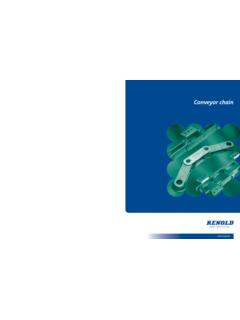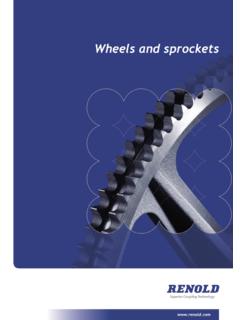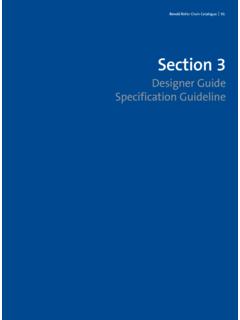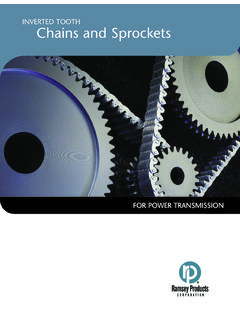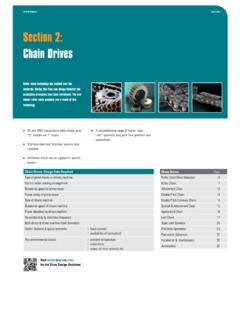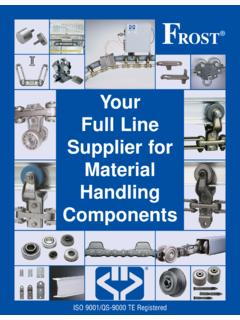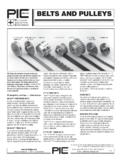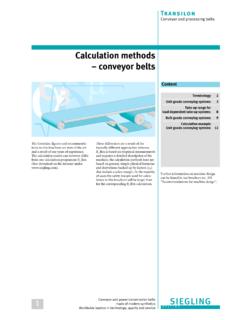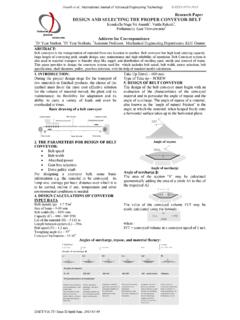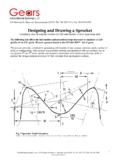Transcription of 1 Technical Information - rulmecacorp.com
1 91 Technical Information project and design criteria for belt conveyors10 TechnicalInformationproject and design criteriafor belt conveyors1 Summary 1 Technical characteristics of belt conveyors .. elements of a belt Material .. speed .. width .. of troughing set, pitch and transition distance .. force, absorbed power, passive .. 36resistance, belt weight, tensions and conveyor drive types and drum dimensions .. , function and critical of roller diameter in relation to speed .. of type in relation to load .. of belt and impact of associated forces on impact rollers .. cleaners .. inversion.
2 conveyor covers .. IntroductionDuring the project design stage for thetransport of raw materials or finishedproducts, the choice of the method mustfavour the most cost effective solution forthe volume of material moved ; the plantand its maintenance ; its flexibility foradaptation and its ability to carry a varietyof loads and even be overloaded at belt conveyor , increasingly used in thelast 10 years, is a method of conveying thatsatisfies the above selection criteria. Com-pared with other systems it is in fact themost economic, especially when one con-siders its adaptability to the most diverseand the most difficult , we are not concerned only withhorizontal or inclined conveyors but alsowith curves, conveyors in descent and withspeeds of increasing ,the consideration in this sectionis not meant to be presented as the" bible"on project design for belt wish to provide you with certain criteriato guide you in the choice of the mostimportant components.
3 And calculationsto help with correct Technical Information contained in thefollowing sections is intended to basicallysupport the designer and be integratedinto the Technical fulfillment of the and design criteriafor belt conveyors1 Symbolsapitch of troughing setsmAlength of roller spindlemmagdistance between the pulley flange and supportmaipitch of impact setsmaopitch of carrying setsmatpitch of transition setsmaupitch of return setsmBlength of roller shellmmCdistance between roller supportsmmCastatic load on the carrying setdaNcaload on central roller of the carrying setdaNCa1dynamic load on the carrying setdaNcddynamic load on the bearingdaNCfconstant of elasticity of the frame/impact rollerKg/mchflats of roller shaftmmCostatic load on bearingdaNCpresulting load of associated forces on motorised drum shaftdaNCprresulting load of associated forces on idler drum shaftdaNCqcoefficient of fixed resistance__Crstatic load on the return setdaNcrload on the roller of return setdaNCr1dynamic load on the return setdaNCtcoefficient of passive resistance given by temperature__Cwwrap factor__ddiameter of spindle/shaftmmDdiameter of roller/pulleymmEmodules of elasticity of steeldaN/mm2elogarithmic natural base2.
4 718fcoefficient of internal friction of material and of rotating parts__facoefficient of friction between the belt and drum given an angleof wrap__frdeflection of belt between two consecutive troughing setsmftdeflection of a symmetrical shaftmmFatangential force to move the belt in the direction of movementdaNFdfactor of impact__Fmenvironmental factor__Fpcontribution factor__Fprcontribution factor on the central roller of a troughing set__Frtangential force to move the belt in the return directiondaNFsservice factor__Futotal tangential forcedaNFvspeed factor__Gdistance between support bracketsmmGmweight of lump of materialKgHheight change of beltmHccorrected height of fallmHfheight of fall of material belt-screenmHtheight change between motorised drum and counterweightmHvheight of fall of material screen - receiving beltmICdistance from centre of motorised drum to the centre ofthe counterweight connectionmIMload volumem3/hIVbelt load (material flow)
5 T/h13 IVMload volume corrected to 1 m/s in relation to the inclinationand irregularity of the feedm3/hIVTload volume theoretic to 1 m/sm3/hJmoment of inertia of section of materialmm4 Kinclination factor__K1correction factor__ ammadmissible stressdaN/mm2 Lload centresmLbdimensions of material lumpmLttransition distancemMfbending momentdaNmMifideal bending momentdaNmMttorsion momentdaNmNbelt widthmmnrevolutions per minuterpmPabsorbed powerkWpddynamic falling forceKgpiimpact force of falling materialKgpicforce impact on central rollerKgPpriweight of lower rotating partsKgPprsweight of upper rotating partsKgqbweight of belt per linear metreKg/mqbnweight of belt densityKg/m2qGweight of material per linear metreKg/mqROweight of the upper rotating parts referred to the troughing set pitch Kg/mqRUweight of the lower rotating parts referred to the troughing set pitch Kg/mqsspecific weightt/m3qTweight of drumdaNRLlength of motorised drum facemmSsection of belt materialm2T0minimum tension at end of load zonedaNT1tension on input sidedaNT2tension on output sidedaNT3tension on idler drumdaNTgtension on belt at the point of counterweight connectiondaNTmaxtension at point of highest belt stressdaNTumaxunitary maximum tension of beltdaN/mmTxtension of the belt at a considered pointdaNTytension of the belt at a considered pointdaNvbelt speedm/sVmaximum rise of edge of
6 BeltmmWmodule of resistancemm3 angle of wrap of belt on pulleydegreee tinclination of rotating symmetrical shaftrad angle of overloaddegreee angle of screen inclinationdegreee inclination of conveyordegreee inclination of side roller of troughing setdegreee 1inclination of intermediate side rollerdegreee 2inclination of external side rollerdegreee efficiency__yangle deflection of bearingdegreeeThe symbol for kilogram (kg) is intendedas a unit of and design criteriafor belt conveyors1 Based on the load large belt conveyors areable to show cost add savings of upto 40-60 % with respect to truck or electrical and mechanical componentsof the conveyor such as rollers, drumsbearings, motors are producedaccording to the highest standards.
7 Thequality level reached by majormanufacturers guarantees function andlong principal components of the conveyor ,rollers and belt, need very little maintenanceproviding the design and the installationhas been correctly performed. Theelastomer belt needs only occasional orsuperficial repair and as the rollers aresealed for life they need no lubrication. Thehigh quality and advanced technology ofRulmeca may reduce even further, orsubstitute, the need for lagging has a life of at least utilisation of adequate accessories toclean the belt at the feed and dischargepoints yields corresponding improvementsto increase the life of the installation withminor Technical characteristics of beltconveyorsThe function of a belt conveyor is tocontinuously transport bulk materials of amixed or homogeneous sort, a variabledistance of some metres to tens ofkilometres.
8 One of the principal componentsof the conveyor is the elastomer belt whichhas a double function :- to contain the conveyed material- to transmit the force necessary to movethe belt conveyor is designed to transportmaterial in a continuous movement on theupper part of the belt surfaces, upper on the carryingstrand and lower on the return strand toucha series of rollers which are mounted fromthe conveyor structure itself in a groupknown as a troughing set. At either end ofthe conveyor the belt wraps around a pulley,one of which is coupled to a drive unit totransmit the most competitive of other transportsystems is certainly that of using lorries,With respect to the latter, the belt conveyorpresents the following advantages.
9 - reduction in numbers of personnel- reduction in energy consumption- long periods between maintenance- independence of the system to its surrounds- reduced business costsLoading hopperReturn idler setsUnloading hopperDrive pulleyReturn pulleyCarryng troughing setsImpact troughing setsBelt - Basic drawing of a belt conveyor15 All these factors combine to limit operationalcosts, especially where excavation workoccurs, or underpasses below hills, roadsor other obstacles. A smooth belt conveyormay travel up slopes up to 18 and thereis always the possibility to recover energyon down hill sections. Projects havetherefore been realised where conveyorsystem lengths may be up to 100 km longwith single sections of conveyor of 15 the characteristics of flexibility,strength and economy of purpose the beltconveyor is the practical solution toconveying bulk and other developments is this field addto these existing following drawings show typical beltconveyor arrangements.
10 conveyor with horizontal conveyor belt with incline and horizontal where twobelts are - conveyor with horizontal belt with incline section,where the space permits a vertical curve and where the loadrequires the use of a single - conveyor with belt loaded in decline or - conveyor with horizontal and incline section wherespace does not allow a vertical curve and the load needs twobelts to be - conveyor with incline belt and following horizontalsection, when the load requires the use of a single belt andwhere space permits a vertical - conveyor with horizontal and incline section wherethe space does not allow the vertical curve but the load mayneed the use of a single - conveyor with a single belt comprising a horizontalsection, an incline section and a decline section with and design criteriafor belt conveyors1 Drive pulleyThe shell face of the conventional drivepulley or the motorised drum may be left asnormal finish or clad in rubber of a thicknesscalculated knowing the power to cladding may be grooved asherringbone design ; or horizontal groovesto the direction of travel ; or diamondgrooves.
